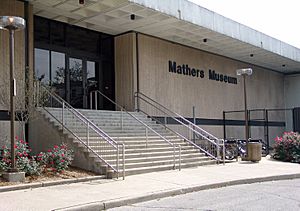Mathers Museum of World Cultures facts for kids
The Mathers Museum of World Cultures was a special museum at Indiana University in Bloomington, Indiana. It showed amazing exhibits of traditional and folk arts from different cultures around the world. The museum also helped university students learn about museum work.
In 2020, the Mathers Museum joined with another important place, the Glenn A. Black Laboratory of Archaeology. Together, they became the new Indiana University Museum of Archaeology and Anthropology (IUMAA). The museum building was closed for a while for updates, but its lobby is now open. A new gallery, called the William Gathers gallery, opened on October 19, 2024. You can find the IUMAA at 416 North Indiana Avenue.
How the Museum Started
The idea for the Indiana University Museum was first shared in 1963. It received money from the university's history and anthropology departments, and a group focused on folklore. The museum opened its very first exhibit in December 1965.
Its first director, Dr. Wesley Hurt, worked hard to make the museum's collection bigger. He went on trips to the Western United States and South America to collect items. He also asked people to donate their collections. By 1970, the museum had so many items and exhibits that it needed a new, larger building. This new place would have better facilities and lots of storage space.
Because of its growth, the museum staff applied to be recognized by the American Association of Museums. They received this important recognition in July 1971. In October 1980, a special ceremony was held to start building the new William Hammond Mathers Museum. The museum was named after William Hammond Mathers, who was the youngest son of Dr. Frank C. Mathers. Dr. Frank C. Mathers was a chemistry professor at IU and gave a lot of money to help build the new museum.
Amazing Collections
The museum's collections include more than 40,000 objects and pictures from cultures all over the world. They have special collections focusing on African, Latin American, and Native American cultures. They also have many musical instruments and items related to Indiana's history.
When the museum first got some of its items, they didn't always have much information about who made them or how they were used. Later, the museum's staff, teachers, and students did special research. They wanted to understand these items better and create exhibits using carefully chosen materials that had lots of information.
Some of the cool things you could find in the museum included:
- Everyday tools from the 1800s, part of the Stevens-Esarey collection.
- Items from West Africa collected by Roy Sieber and Arnold Rubin.
- Native American materials from the Ellison collection.
- Pacific artifacts and pottery from Hendricksville, given by Henry and Cecilia Wahl.
- Hundreds of objects from the Tetela people of the Congo, collected by John White.
- A collection of musical instruments from around the world, from Laura Boulton.
- Many everyday objects from the Caboclos people, gathered by the museum with IU anthropologists.
- Nearly 200 items related to botánicas (shops selling herbs and spiritual items), collected for an exhibit called Botánica: A Pharmacy for the Soul.
- African pottery donated by William Simmons.
- Special clothing and items linked to central African royalty, collected by Allen Davis.
- Chairs made by Chester Cornett and other Kentucky chair makers.
- Over 400 West African clothes from Mary Warren's collection.
- Native American materials from the Great Lakes region, given by Elinor and Vincent Ostrom.
- Works bought from the Eastern Band of Cherokee Indians' Qualla Arts and Crafts Mutual cooperative.
- A large airplane-shaped fantasy coffin made by Paa Joe Coffin Works in Ghana, donated by Robert and Alice Schloss. The museum also collected information and tools from this workshop.
- Information about traditional arts in China, collected by museum staff for a project with Chinese and U.S. museums.
Traditional Arts Indiana
Traditional Arts Indiana, which is the state's program for traditional arts, was part of the museum starting in 2015. It later moved to IU's Cook Center for Public Arts and Humanities in 2020. While it was at the Mathers Museum, its director, Jon Kay, worked with museum staff on research, presentations, performances, and exhibits. One exhibit, Creative Aging, was based on Jon Kay's 2016 book Folk Art and Aging.


